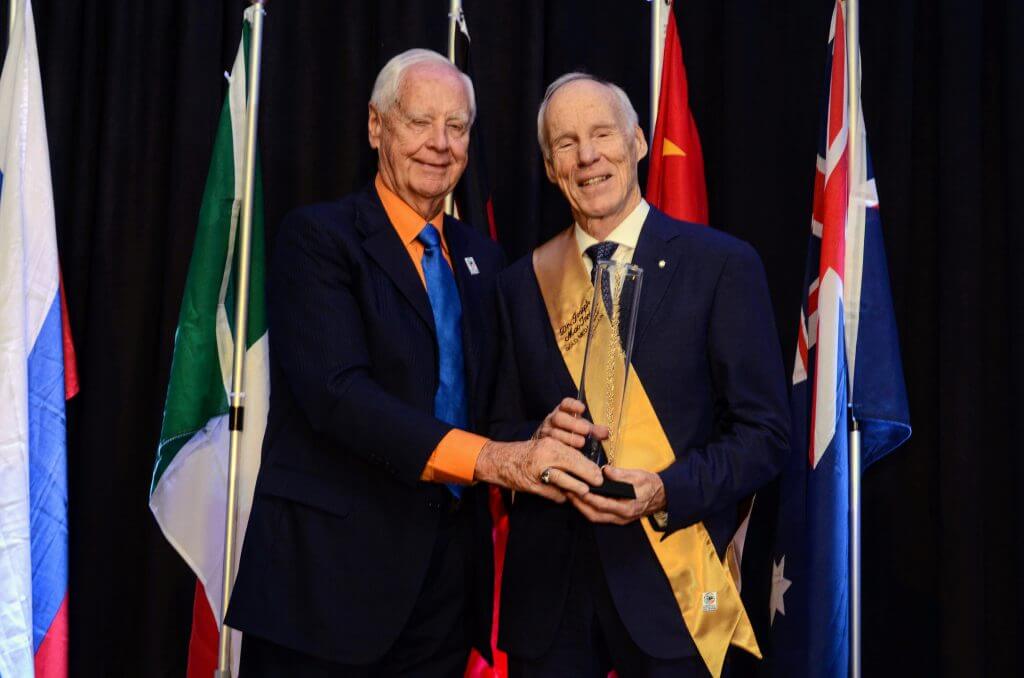Dr. Joseph MacInnis Receives International Swimming Hall of Fame’s Gold Medallion Award (VIDEO)

He was born in the bay-front city of Barrie, Ontario, Canada, in 1937, and had a love of the water from an early age.
Water is much more than a drink to Dr. Joseph MacInnis. It is a passion that was heightened by a visit to Fort Lauderdale for the Annual Christmas Swim Forum in 1954. It was here where Canada’s intercollegiate breaststroke champion and the captain of the University of Toronto’s swim team, made his first dive.
When he dropped into the water over Fort Lauderdale’s second reef, it was a life-changing experience. The things he saw and heard…everything from the Queen Angel fish to the sound of silence was beautiful. He knew that whatever he did after that, it had to be in concert with the ocean.
After his swimming career ended in 1958, he continued at UT as a medical student, always with the idea of combining medicine with the sea. He wasn’t sure how, but as men were beginning to explore the undersea world, he believed they were going to need a good physician.
Rather than working in hospitals during the summer, MacInnis dove in local waters and took off for Florida and the Bahamas whenever he could. By 1960, he had become an expert skin and SCUBA diver and saw his first article on the subject published.
It was after earning his M.D., during his internship, that he encountered a tunnel construction worker suffering from decompression sickness. It was then that MacInnis decided to pursue diving medicine in his post-graduate years at the University of Pennsylvania.
In 1964, he was chosen to be the life support physician for phase two of the Man in Sea project sponsored by the National Geographic Society and Smithsonian Institution. In 1965, he directed over 75 experimental dives for OceanSystems, Inc., then the world’s largest commercial diving company, and in 1967 became a consultant to the USNavy’s Sealab project. MacInnis was certified by the US Navy, in 1968 as a Man-In-Sea Aquanaut for its Sealab III program.
MacInnis constructed Sublimnos, Canada’s first subsurface research laboratory in 1969. It was the only freshwater underwater lab, the only under-ice station and it was the only “free “submerged habitat in the world. It was inspiration to Pierre Trudeau, who himself was a diver and a year later Trudeau asked MacInnis to help write Canada’s first national ocean policy. Supported by the Canadian Government, he began a series of ten research expeditions to study techniques for working under the Arctic Ocean. Later that year, Dr. MacInnis founded the James Allister MacInnis Foundation for underwater research education in Canada.
He led a team that constructed the first manned underwater station, “Sub Igloo,” in the Arctic Ocean in 1972, years later, he took His Royal Highness Prince Charles of Wales on a dive under the polar ice cap. MacInnis was the first person to explore the freezing waters under the North Pole and by the mid-1970’s, had been on more than 100 expeditions and major dives around the world. In 1976, he became a member of the Order of Canada, his nation’s highest honor, for his pioneering research on undersea science and engineering projects.
While diving in 1975, Dr. MacInnis discovered a fragment of the world’s northernmost-known shipwreck, the HMS Breadalbane. It was a British merchant ship that sank over 100 years prior under the ice of the Northwest Passage and in 1978, he headed a five-man crew for the first expedition to find the whole wreck of the ship.
After a long search, the ship was discovered in 1980 using side-scan sonar in the waters south of Beechy Island in the Canadian Arctic Archipelago. A year later, MacInnis’ group returned for a more detailed look, but this time they were accompanied by the Canadian Coast Guard, the National Geographic Society and other institutions. A remotely piloted submersible was lowered 100 meters into the lethally cold water, and the first color photographs were taken with still and video cameras.
A highlight of MacInnis’ career was in 1985 when he was an adviser to the team that discovered the wreck of the RMS Titanic. In 1987, aboard the French submersible Nautile, he made his first nine-hour dive to the Titanic at 4,000 m. south of Newfoundland.
In 1991, he was the co-leader of a $5 million expedition to film Titanic on the giant-screen IMAX format, He made a second nine-hour dive that included spending time on Titanic’s bridge deck.It was his expedition that inspired Canadian filmmaker James Cameron’s Academy Award winning film, which hit the big screens in 1997.
As fate would have it, Cameron made his first contact with MacInnis after seeing Sublimnos in front of the Royal Ontario Museum. He wrote MacInnis asking for the blue prints for Sublimnos. MacInnis wrote him back and encouraged the14-year-old Cameron to embrace his love of diving and undersea exploration. They’ve been friends ever since.
MacInnis has assisted Cameron on numerous expeditions since the Titanic film. In 2003, MacInnis accompanied Cameron on the Disney-IMAX expedition to the Atlantic and Pacific Oceans, which resulted in the 3-D film, Aliens of the Deep.
In 2005, MacInnis teamed with Cameron for the Discovery Channel expedition which broadcast live images of the last remaining unseen rooms of the Titanic. The expedition involved the world’s largest research ship, 130 people, two, $2 million subs and five mini-robots.
In 2012, he was expedition physician and journalist for Cameron and National Geographic for the seven-mile deep solo science dive into the Mariana Trench in the western Pacific Ocean, the deepest natural trench in the world.
Dr. MacInnis has spent 6,000 hours working inside the Atlantic, Pacific and Arctic Oceans. He has authored nine books about undersea science and engineering projects and the leadership needed to make them succeed. They have been published by Random House, Penguin and National Geographic.
Dr. MacInnis currently examines and writes about leadership and team genius in lethal environments.




